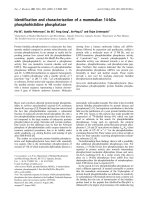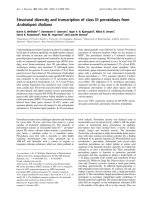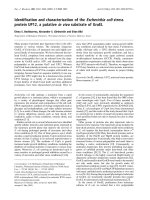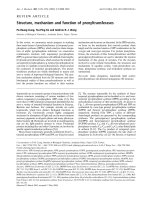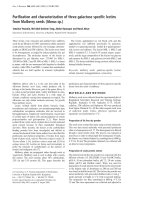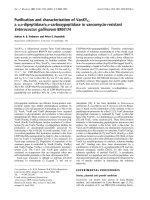Báo cáo y học: "Controlling Osteogenesis and Adipogenesis of Mesenchymal Stromal Cells by Regulating A Circadian Clock Protein with Laser Irradiation" pptx
Bạn đang xem bản rút gọn của tài liệu. Xem và tải ngay bản đầy đủ của tài liệu tại đây (1.88 MB, 8 trang )
Int. J. Med. Sci. 2008, 5
319
International Journal of Medical Sciences
ISSN 1449-1907 www.medsci.org 2008 5(6):319-326
© Ivyspring International Publisher. All rights reserved
Research Paper
Controlling Osteogenesis and Adipogenesis of Mesenchymal Stromal Cells
by Regulating A Circadian Clock Protein with Laser Irradiation
Toshihiro Kushibiki
1,2
and Kunio Awazu
3
1. Frontier Research Center, Graduate School of Engineering, Osaka University, 2-1 Yamadaoka, Suita, Osaka, 565-0871,
Japan
2. PRESTO, Japan Science and Technology Agency, 4-1-8 Honcho Kawaguchi, Saitama, 332-0012, Japan
3. Division of Sustainable Energy and Environmental Engineering, Graduate School of Engineering, Osaka University, 2-1
Yamadaoka, Suita, Osaka, 565-0871, Japan
Correspondence to: Toshihiro Kushibiki, , Phone/Fax +81-6-6878-6330
Received: 2008.09.16; Accepted: 2008.10.23; Published: 2008.10.26
Mesenchymal stromal cells (MSCs) are multipotent cells present in adult bone marrow that replicate as
undif-
ferentiated cells and can differentiate
to lineages of mesenchymal tissues. Homeostatic control of bone remodel-
ling maintains bone mass by insuring that bone resorption and bone formation occur sequentially and in a bal-
anced manner. As most homeostatic functions occur in a circadian manner, a circadian clock could control bone
mass. Here, we show that laser irradiation can direct the osteogenesis and adipogenesis of mouse MSCs by al-
tering the intracellular localization of the circadian rhythm protein Cryptochrome 1 (mCRY1). After laser irra-
diation (wavelength: 405 nm) to MSCs, circadian rhythm protein, mCRY1 and mPER2, were immunostained and
histochemical stainings for osteogenic or adipogenic differentiation were observed. Laser irradiation promoted
osteogenesis and reduced adipogenesis of MSCs, induced the translocation of mCRY1 and mPER2 protein from
the cytoplasm to the nucleus, and decreased mCRY1 mRNA levels quantified by real-time PCR. Since the timing
of nuclear accumulation of clock proteins constitutes an important step in the transcription-translation feedback
loop driving the circadian core oscillator, laser irradiation could provide a simple and effective technology for
clock protein localization and turnover. Our results also indicate that mCRY1 is a master regulator of circadian
rhythm that regulates the differentiation of MSCs. Laser irradiation could provide a simple and effective means
of controlling the fate of MSCs as a therapeutic strategy and act ‘molecular switch’ of regulatory proteins by
suppressing CRY transcription. Furthermore, this model system may be useful for exploring the crosstalk be-
tween circadian rhythm and cell differentiation.
Key words: cryptochrome, osteogenesis, adipogenesis, laser, mesenchymal stromal cells
INTRODUCTION
Organisms have evolved various methods for ef-
ficient utilization of light energy. Light has an espe-
cially important role as a stimulus for many develop-
mental processes. For example, blue light markedly
affects growth and development of higher plants.
These responses are mediated by a blue light photo-
receptor, cryptochrome (CRY).
1
CRY shares significant
homology with Class I cyclobutane pyrimidine dim-
mers (CPD) photolyase, although it does not exhibit
photolyase activity. CRY also binds flavin adenine
dinucleotide (FAD),
2,3
consistent with CRY mediating
a light-dependent redox reaction similar to CPD
photolyase. However, genetic analysis indicates
that
the CRYs, which utilize flavin as light-absorbing co-
factors, are the primary circadian photoreceptors.
4
Circadian rhythms are oscillations in the behav-
iour and biochemical
reactions of organisms that occur
with a periodicity of approximately
twenty-four hours.
Circadian rhythms are thought to confer a selective
advantage
to organisms by enabling them to pursue
levels of activity that
are optimal for growth and de-
velopment and minimize susceptibility to
predation
and competition by establishing favourable temporal
niches. In mammals, the core oscillator of the master
circadian clock utilizes interacting positive and nega-
tive transcription-translation feedback loops.
5
Proteins
involved in these feedback loops include two crypto-
chrome genes, Cry1 and Cry2, three homologs of the
period genes, Per1, Per2, and Per3, and the transcrip-
tional activator genes, Clock and Bmal1 (Brain and
Muscle aryl hydrocarbon
receptor nuclear translocator
Int. J. Med. Sci. 2008, 5
320
(ARNT)-Like protein 1).
6
A key step in these feedback
loops is the shutdown of CLOCK- and BMAL1-driven
transcription by CRY proteins. BMAL1 and
CLOCK
contain two basic helix-loop-helix
domains and bind
E-box elements (CACGTG) in the Per and Cry
clock
genes to activate their transcription. This activity is a
positive feedback loop of circadian
rhythm regula-
tion.
7
The mammalian Period proteins
(PER1 and
PER2) and Cryptochrome
proteins (CRY1 and CRY2)
act as
negative regulators of transcription driven by
the BMAL1/CLOCK
heterodimer. Therefore, E-box
elements play a crucial role in homeostatic function.
For example, homeostatic control of bone re-
modelling maintains bone mass by insuring that bone
resorption and bone formation occur sequentially and
in a balanced manner.
7,8
As most homeostatic func-
tions occur in a circadian manner,
9,10
a circadian clock
could control bone mass
11
. Bone mass is regulated by
osteoblasts that differentiate from mesenchymal stro-
mal cells (MSCs). MSCs are multipotent cells that can
replicate as
undifferentiated cells and that have the
potential to differentiate
to lineages of mesenchymal
tissues, including bone, cartilage,
fat, tendon, and
muscle.
12,13
Accordingly, controlling the division and
differentiation of MSCs would provide an exceptional
therapeutic resource for the restoration of damaged or
diseased tissue. However, several fundamental ques-
tions must be answered before it will be feasible to
dictate the differentiation of MSCs implanted to
ma-
ture organisms. In particular,
a better understanding
of how specific factors alter the
differentiation of
MSCs is essential. Here, we show that blue laser
(wavelength; 405 nm) irradiation can induce and re-
duce the osteogenesis and adipogenesis by altering the
intracellular localization of the circadian rhythm pro-
tein CRY1.
MATERIALS AND METHODS
Cell culture and laser irradiation
The mouse MSCs cell line (KUSA-A) was pur-
chased from RIKEN Bioresource Center, Japan, and
cultured in Dulbecco’s Modified Eagle’s Medium
(DMEM) containing 10% fetal calf serum (FCS), 100
units/mL penicillin, and 0.1 mg/mL streptomycin at
37°C in a 5% CO
2
atmosphere. For osteogenic induc-
tion, MSCs were seeded at 4×10
4
cells/well in a Black
with Clear Bottom 96-well Microtest™ Optilux™ Plate
(BD bioscience Inc., CA) for 12 hrs. Following the re-
setting of circadian rhythms by dexamethasone (100
nM for 1 hr),
14,15
cells were irradiated with a blue laser
(VLM 500
®
, Sumitomo Electric Industries, Ltd., Japan,
wavelength: 405 nm, continuous wave) for 180 sec via
a fiber attached to the bottom of the culture dish. The
optical instrument with an automated stage for posi-
tioning was purchased from Sigma Koki Co., Ltd., Ja-
pan. The beam profile of this laser system was ob-
served with a LEPAS-11 Laser Beam Profiler
(Hamamatsu Photonics K.K., Japan). A diameter of
circular beam was approximately 500 μm. A blue laser
was irradiated to cells cultured only in the center of
well. After laser irradiation, MSCs were incubated in
osteogenic differentiation medium (DMEM supple-
mented with 10% FCS, 10 nM dexamethasone,
50 μg/ml ascorbic acid, and 2 mM
β-glycerophosphate) or adipogenic differentiation
medium (DMEM supplemented with 10% FCS,
100 nM dexamethasone, 0.5 mM
3-isobutyl-1-methylxanthine, 10 μg/ml insulin, and
0.2 mM indomethacin) at 37°C in a 5% CO
2
atmos-
phere for 5 days. As control experiments, MSCs were
incubated in the same conditions above, except for
laser irradiation.
Histochemical analysis
For immunostaining of mCRY1 or mPER2, cells
were fixed with 4% formalin in phosphate buffered
saline (PBS, pH 7.4) 24 hrs after irradiation. Fixed cells
were incubated with a primary antibody directed
against anti-mouse CRY1 (Alpha Diagnostic Interna-
tional, Inc., TX) or PER2 (Chemicon International, Inc.,
CA) for 1 hr at room temperature, followed by incuba-
tion with a Cy3-conjugated second antibody
(Sigma-Aldrich, Inc. MO) for 1 hr at room tempera-
ture. Cells were counterstained with
4,6-diamidino-2-phenylindole (DAPI). Only irradiated
cells (around 500μm in the center of plate well) were
observed by fluorescence microscopy. To evaluate
osteogenesis, MSCs were rinsed three times with PBS
and fixed with 4% formalin in PBS. Fixed cells were
incubated with a 1% Alizarin red-S (Sigma-Aldrich,
Inc. MO) aqueous solution (pH 6.5) for 15 min at room
temperature and then rinsed three times with PBS. For
von Kossa staining, fixed cells were exposed to UV
light for 30 min in the presence of 5% silver nitrate
and then incubated with 5% sodium thiosulfate for 5
min. The stained cells were rinsed with deionized wa-
ter. For ALP staining, cells were stained using naph-
thol AS-BI phosphate solution and fast red violet solu-
tion (ALP detection kit, Chemicon International, Inc.,
CA). For osteocalcin immunostaining, fixed cells were
incubated with a primary antibody (LSL Co., Cosmo
Bio, Japan) directed against mouse osteocalcin for 1 hr
at room temperature, followed by incubation with a
Cy3-conjugated second antibody (Sigma-Aldrich, Inc.
MO) for 1 hr at room temperature. The calcium con-
tents of differentiated cells were measured with the
calcium-E test kit (Wako Pure Chemical Industries,
Ltd., Japan). To examine the state of adipose differen-
Int. J. Med. Sci. 2008, 5
321
tiation, fixed cells were stained with 0.5% oil red O in
an isopropanol/water solution for 1 hr. After staining,
cultures were rinsed several times with a 70% ethanol
solution.
RNA extraction and real time PCR
Total cellular RNA of laser irradiated or
non-irradiated MSCs was extracted with the
RNAqueous kit (Ambion, Inc., Japan) according to the
manufacturer’s instructions 24 hr after laser irradia-
tion. All samples were subjected to DNase treatment
to avoid DNA contamination. mCRY1 or Peroxisome
Proliferator-Activated Receptor (PPAR) γ mRNA ex-
pression was quantified by real time PCR. Reactions
were carried out using a Smart Cycler version II (Ta-
kara Bio, Inc., Japan) with a SYBR ExScript RT-PCR kit
(Takara Bio, Inc., Japan). PCR was started with an ini-
tial incubation at 95°C for 15 min to activate the Taq
DNA polymerase, then set at 94°C for 15 sec, 56°C for
30 sec, and 72°C for 30 sec, for 40 cycles. Fluorescent
signals were measured at the end of each elongation
step and the start points of their exponential curves
were determined for conversion of the cycle number
into the amount of PCR product. Purified cDNA was
employed to generate standard curves. The PCR effi-
ciency of the primer sets was checked to confirm that
the dilution rate of the samples was not affected. First,
the annealing temperature of the eight wells of the
PCR reaction plate on the apparatus was changed
linearly from 55°C to 65°C to determine the optimal
annealing temperature between the two sets of PCR
primers. After the final PCR step, the temperature was
elevated to 95°C while monitoring the fluorescent
signals in order to form the melting curves to check
the specificity of the PCR amplification. The levels of
mCRY1 mRNA were normalized to the amount of
mouse ribosomal protein S18 (Rps18) mRNA in each
sample. Values were calculated as means ± standard
deviation (SD). Comparisons between groups were
made using Student’s t-test. Differences were accepted
as significant when P < 0.01.
Statistical analysis
All the data were expressed as the mean ± the
standard derivation of the mean. Statistical signifi-
cance (defined as P values of less than 0.01) was
evaluated based on the unpaired Student’s t test
(two-tailed).
RESULTS
Intracellular distribution of mCRY1 and mPER2, and
real-time PCR quantification of mCRY1 mRNA after
laser irradiation
Intracellular distribution of mCRY1 and mPER2
after blue laser irradiation were shown in Figs. 1a and
1b. Blue laser irradiation to mouse MSCs promotes the
nuclear accumulation of mCRY1 (Fig. 1A) and mPER2
(Fig. 1B). In addition, the mRNA levels of mCRY1,
quantified by real-time PCR, decreased 24 hr after
blue laser irradiation relative to non-irradiated cells
(Fig. 1C). These results reveal that blue laser irradia-
tion of mouse MSCs promotes the nuclear accumula-
tion of mCRY1 and mPER2 and decreases their ex-
pressions via a negative feedback loop.
Int. J. Med. Sci. 2008, 5
322
Figure 1 Intracellular location of (A) mCRY1 and (B) mPER2 proteins in MSCs 24 hr after laser irradiation. Cells were dou-
ble-labeled with DAPI (blue, upper panel) and mCRY1 or mPER2 (red, center panel). The lower panel provides a merged image.
mCRY1 and mPER2 localized to the cytoplasm prior to laser irradiation. After laser irradiation, proteins translocated to the nucleus.
(C) mRNA levels of mCry1 in MSCs 24 hr after laser irradiation (100 mW/cm
2
) and in non-irradiated cells. Samples were nor-
malized to mRps18. The mRNA levels of mCry1 decreased after blue laser irradiation relative to non-irradiated cells. Scale bars =
30µm *, p<0.01: significant difference between the relative mRNA levels of laser irradiated MSCs and controls.
Oteogenesis and adipogenesis of MSCs after laser
irradiation
Irradiating cultured MSCs with a circular beam
(Fig. 2A) stimulated osteogenesis exclusively within
the area irradiated. Five days after blue laser irradia-
tion, alizarin red-S and von Kossa staining revealed
extensive calcium and calcium phosphate deposition
that increased with laser energy (Fig. 2B). The calcium
content of these wells was also increased (Fig. 2C).
Laser irradiated samples displayed alkaline phos-
phatase (ALP) activity and were immunopositive for
osteocalcin, a marker of osteoblast differentiation (Fig.
2B). Staining with oil red O (Fig. 3A) and PPAR
γ
mRNA expression (Fig. 3B) indicated that blue laser
irradiation decreased adipogenesis.
Int. J. Med. Sci. 2008, 5
323
Figure 2 (A) The beam profile of the blue laser (wave length; 405
nm, continuous wave). MSCs were irradiated for 180 sec at various
intensities. (B) Histochemical analysis of laser irradiated MSCs.
Alizarin red-S staining of irradiated MSCs (magnification: x50). At
5 days post-irradiation, calcium deposition had increased around
the cells in a dose-dependent manner. Calcium phosphate deposi-
tion was evaluated by von Kossa staining (magnification: x50). At
5 days after treatment, staining increased with increased laser en-
ergy. The area expressing alkaline phosphatase (ALP) activity was
stained (magnification: x50). Laser irradiated samples displayed
immunopositive staining for osteocalcin, a marker of osteoblast
differentiation (magnification: x100). Scale bars = 200 (for Alizarin
red-S, von Kossa, and ALA staining) and 100µm (for osteocalcin
immunostaining). (C) The quantitative calcium content increased
after blue laser irradiation relative to non-irradiated cells. Calcium
content increases varied with laser energy. *, p<0.01: significant
difference between the calcium content of laser-irradiated MSCs and controls.
Int. J. Med. Sci. 2008, 5
324
Figure 3 (A) Staining with oil red O demonstrates that blue laser
irradiation decreased adipogenesis relative to non-irradiated areas
(magnification: x50). Higher magnification (x400) is shown in
frame. Scale bars = 200 µm. As the nuclear localization of CRY
proteins attenuates CLOCK- and BMAL1-driven transcription,
laser irradiation may act ‘molecular switch’ for regulatory proteins
by suppressing CRY transcription to limit the accumulation of lipid
droplets in cells. (B) mRNA levels of PPAR
γ
in MSCs 24 hr after
laser irradiation (100 mW/cm
2
) and in non-irradiated cells. Samples
were normalized to mRps18. The mRNA levels of PPAR
γ
de-
creased after blue laser irradiation relative to non-irradiated cells. *,
p<0.01: significant difference between the relative mRNA levels of
laser irradiated MSCs and controls.
DISCUSSION
In this study, we demonstrate that blue laser ir-
radiation of mouse MSCs promotes the nuclear accu-
mulation of mCRY1 (Fig. 1A) and mPER2 (Fig. 1B).
Since the timing of nuclear accumulation of clock pro-
teins constitutes an important step in the transcrip-
tion-translation feedback loop driving the circadian
core oscillator,
17
laser irradiation could provide a sim-
ple and effective technology for clock protein localiza-
tion and turnover. In addition, transcriptional regula-
tion is also fundamental to the circadian oscillations of
clock gene expression. The mRNA levels of mCRY1
decreased after blue laser irradiation relative to
non-irradiated cells (Fig. 1C). Protein products of CRY
act together with PER proteins to inhibit CRY and PER
transcription and close the autoregulatory feedback
loop.
5,6
These oscillations control output rhythms. The
transcriptional feedback loop and a model of inter-
locked loops have been proposed as the basis for these
oscillations. These results reveal that blue laser irra-
diation of mouse MSCs promotes the nuclear accu-
mulation of mCRY1 and mPER2 and decreases their
expressions via a negative feedback loop.
In addition, we demonstrate that irradiaton with
a blue laser enhances the osteogenesis and suppress
the adipgenesis of mouse MSCs. Irradiating cultured
MSCs with a circular beam (Fig. 2A) stimulated os-
teogenesis exclusively within the area irradiated (Fig.
2B). Since a functional hallmark of osteoblasts is their
ability to mineralize the extra cellular matrix (ECM),
we stained irradiated cultures with alizarin red and
Int. J. Med. Sci. 2008, 5
325
von Kossa staining to detect calcium and calcium
phosphate deposition, respectively. CRY is a key pro-
tein for the differentiation of MSCs and bone nodule
formation. Mice lacking Cry1 and 2 (Cry1
−/−
;Cry2
−/−
)
exhibit higher bone mass, consistent with the hy-
pothesis that dysfunction of the molecular clock in-
fluences bone remodeling.
11
In addition, the E-box is
essential for tissue-specific transcriptional activation
of mouse bone morphogentic protein (BMP)-4 and
osteogenic lineage-specific novel transcriptional fac-
tor(s) recognizes this E-box.
18
The diurnal variation in
the synthesis of type I collagen and osteocalcin, the
two main biosynthetic products of osteoblasts, sup-
ports this hypothesis.
19,20
Adipocytes also play essential metabolic roles.
They not only provide massive energy reserves but
also secrete hormones and cytokines that regulate
metabolic activities.
21
The link between metabolic ac-
tivity in adipocytes and circadian rhythm has been
studied extensively. For example, glucose and lipid
homeostasis exhibit circadian variation. More recently,
the expression of adiponectin receptors in adipocytes
has been reported to vary in a circadian fashion.
22
An-
other clock protein, BMAL1, regulates adipogenesis
and lipid metabolic activity in mature adipocytes.
23
In
our cultures, staining with oil red O and quantification
of PPAR
γ
mRNA indicated that blue laser irradiation
decreased adipogenesis (Figs. 3A and 3B).
These phenomena were indicated that a blue la-
ser irradiation is ‘speeding up’ a sequence of events
that will occur anyway under these culture conditions.
Thus, laser irradiation may act ‘molecular switch’ of
regulatory proteins by suppressing CRY transcription
to enhance the osteogensis and to limit the accumula-
tion of lipid droplets in cells. Recent evidence indi-
cates that at low-radiation doses light energy is ab-
sorbed by intracellular chromophores.
24
Current mod-
els propose that low-level laser irradiation generates a
small amount of singlet oxygen that influences the
formation of adenosine triphosphate (ATP).
25
In addi-
tion, laser irradiation may increase the transmembrane
electrochemical proton gradient in mitochondria to
improve the efficiency of the proton-motive force and
generate greater calcium release by an antiport proc-
ess.
26
A number of different lasers with different
wavelengths, including helium-neon (wavelength;
632.8 nm), gallium-aluminum-arsenide (wavelength;
805±25 nm), and gallium-arsenide (wave length; 904
nm), have been used at different intensities and treat-
ment schedules for repairing bone defects. However,
few studies have attempted to quantify the effect of
low-level laser therapy on bone formation.
27
We demonstrate that mCRY1 is a master regula-
tor of circadian rhythm that can regulate the differen-
tiation of MSCs following blue laser irradiation. The
detailed mechanism of relationship between
photo-acceptance of CRY, CRY down-regulation, and
cell differentiation by blue laser irradiation were not
unclear. However, irradiation with lasers at different
wavelengths, 664 and 808 nm, did not alter the intra-
cellular distribution of mCRY1 and mPER2 and did
not affect on the cell differentiation (data not shown).
This observation provides additional evidence for the
specific photoreceptive
function of CRY proteins.
There are several reports that mCRY is the only
blue-light photoreceptor implicated in circadian
photoresponses.
14,28-33
Mammalian CRY1 bound to
FAD contributes to photoreception of 405 nm light by
murine cells. Although the blue laser irradiation used
in this study was extremely high energy compared
with that in natural light, our results indicate that
mCRY1 plays an important role in the control of the
differentiation of MSCs. We propose that blue laser
irradiation of MSCs could provide a simple and effec-
tive technology for clock protein localization and
turnover as the timing of nuclear accumulation of
clock proteins constitutes an important step in the
transcription-translation feedback loop driving the
circadian core oscillator. We examine the effect of laser
irradiation in other types of cells, such as primary os-
teoblasts and primary bone marrow stromal cells.
Those results will be reported in near future. As this
technique could readily be applied in situ to control
the differentiation of MSCs at an implanted site within
the body, this approach may have therapeutic poten-
tial for the restoration of damaged or diseased tissue.
Furthermore, these findings provide an excellent op-
portunity to gain insights into the cross-talk between
circadian rhythms, bone formation and adipose me-
tabolism.
Acknowledgements
A part of this paper was published as a patent,
US-patent Pub. No. 20080057580 A1, Mar. 6, 2008.
Conflict of Interest
The authors have declared that no conflict of in-
terest exists.
References
[1] Short TW, Briggs WR. The transduction of blue light signals in
higher plants. Annu Rev Plant Physiol Plant Mol Biol
1994;45:143-171.
[2] Lin C, Robertson DE, Ahmad M, Raibekas AA, Jorns MS, Dutton
PL, Cashmore AR. Association of flavin adenine dinucleotide
with the Arabidopsis blue light receptor CRY1. Science
1995;269:968–970.
[3] Todo T, Kim ST, Hitomi K, Otoshi E, Inui T, Morioka H, Koba-
yashi H, Ohtsuka E, Toh H, Ikenaga M. Flavin adenine dinu-
Int. J. Med. Sci. 2008, 5
326
cleotide as a chromophore of the Xenopus (6-4)photolyase. Nu-
cleic Acids Res 1997;25:764-768.
[4] Hsu DS, Zhao X, Zhao S, Kazantsev A, Wang RP, Todo T, Wei
YF, Sancar A. Putative human blue-light photoreceptors hCRY1
and hCRY2 are flavoproteins. Biochemistry
1996;35:13871–13877.
[5] Young MW. Circadian rhythms. Marking time for a kingdom.
Science 2000;288: 451-453.
[6] Shearman LP, Sriram S, Weaver DR, Maywood ES, Chaves I,
Zheng B, Kume K, Lee CC, van der Horst GT, Hastings MH,
Reppert SM. Interacting molecular loops in the mammalian cir-
cadian clock. Science 2000;288:1013-1019.
[7] Rodan GA Martin TJ. Therapeutic approaches to bone diseases.
Science 2000;289: 1508-1514.
[8] Boyle WJ, Simonet WS, Lacey DL. Osteoclast differentiation and
activation. Nature 2003;423:337-342.
[9] Lowrey PL, Takahashi JS. Mammalian circadian biology: eluci-
dating genome-wide levels of temporal organization. Annu Rev
Genomics Hum Genet 2004;5: 407-441.
[10] Perreau-Lenz S, Pevet P, Buijs RM, Kalsbeek A. The biological
clock: the bodyguard of temporal homeostasis. Chronobiol Int
2004;21:1-25.
[11] Fu L, Patel MS, Bradley A, Wagner EF, Karsenty G. The mo-
lecular clock mediates leptin-regulated bone formation. Cell
2005;122:803-815.
[12] Thomson JA, Itskovitz-Eldor J, Shapiro SS, Waknitz MA, Swier-
giel JJ, Marshall VS, Jones JM. Embryonic stem cell lines derived
from human blastocysts. Science 1998;282:1145-1147.
[13] Pittenger MF, Mackay AM, Beck SC, Jaiswal RK, Douglas R,
Mosca JD, Moorman MA, Simonetti DW, Craig S, Marshak DR.
Multilineage potential of adult human mesenchymal stem cells.
Science 1999;284:143-147.
[14] Balsalobre A, Brown SA, Marcacci L, Tronche F, Kellendonk C,
Reichardt HM, Schutz G, Schibler U. Resetting of circadian time
in peripheral tissues by glucocorticoid signalling. Science
2000;289:2344-2347.
[15] Wu X, Yu G, Parks H, Hebert T, Goh BC, Dietrich MA, Pelled G,
Izadpanah R, Gazit D, Bunnell BA, Gimble JM. Circadian
mechanisms in murine and human bone marrow mesenchymal
stem cells following dexamethasone exposure. Bone.
2008;42:861-870.
[16] Kobayashi K, Kanno S, Smit B, van der Horst GT, Takao M,
Yasui A. Characterization of photolyase/blue-light receptor
homologs in mouse and human cells. Nucleic Acids Res
1998;26:5086-5092.
[17] Young MW, Kai SA. Time zones: a comparative genetics of
circadian clocks. Nature Rev Genet 2001;2:702-715.
[18] Kawasaki S, Ebara S, Nakayama K, Takaoka K. The E-Box motif,
recognized by tissue-specific nuclear factor(s), is important for
BMP-4 gene expression in osteogenic cells. Biochem Biophys Res
Commun 1999;263:560-565.
[19] Simmons DJ, Nichols G Jr. Diurnal periodicity in the metabolic
activity of bone tissue. Am J Physiol 1966;210:411-418.
[20] Gundberg CM, Markowitz ME, Mizruchi M, Rosen JF. Osteo-
calcin in human serum: a circadian rhythm. J Clin Endocrinol
Metab 1985;60:736-739.
[21] Spiegelman BM Flier JS. Obesity and the regulation of energy
balance. Cell 2001;104:531–543.
[22] Bluher M, Fasshauer M, Kralisch S, Schon MR, Krohn K,
Paschke R. Regulation of adiponectin receptor R1 and R2 gene
expression in adipocytes of C57BL/6 mice. Biochem Biophys Res
Commun 2005;329:1127–1132.
[23] Shimba S, Ishii N, Ohta Y, Ohno T, Watabe Y, Hayashi M, Wada
T, Aoyagi T, Tezuka M. Brain and muscle Arnt-like protein-1
(BMAL1), a component of the molecular clock, regulates adipo-
genesis. Proc Natl Acad Sci U S A 2005;102:12071-12076.
[24] Friedmann H, Lubart R, Laulicht I. A possible explanation of
laser-induced stimulation and damage of cell cultures. J Photo-
chem Photobiol B 1991;11:87-91.
[25] Amat A, Rigau J, Waynant RW, Ilev IK, Tomas J, Anders JJ.
Modification of the intrinsic fluorescence and the biochemical
behavior of ATP after irradiation with visible and near-infrared
laser light. J Photochem Photobiol B 2005;81:26-32.
[26] Mochizuki-Oda N, Kataoka Y, Cui Y, Yamada H, Heya M,
Awazu K. Effects of near-infra-red laser irradiation on adenosine
triphosphate and adenosine diphosphate contents of rat brain
tissue. Neurosci Lett 2002;323:207-210.
[27] Ozawa Y, Shimizu N, Kariya G, Abiko Y. Low-Energy Laser
Irradiation stimulates bone nodule formation at early stages of
cell culture in rat calvarial cells. Bone 1998;22:347–354.
[28] Miyamoto Y, Sancar A. Vitamin B2-based blue-light photore-
ceptors in the retinohypothalamic tract as the photoactive pig-
ments for setting the circadian clock in mammals. Proc Natl
Acad Sci U S A 1998;95:6097-6102.
[29] Thresher RJ, Vitaterna MH, Miyamoto Y, Kazantsev A, Hsu DS,
Petit C, Selby CP, Dawut L, Smithies O, Takahashi JS, Sancar A.
Role of mouse cryptochrome blue-light photoreceptor in cir-
cadian photoresponses. Science 1998;282:1490-1494.
[30] van der Horst GT, Muijtjens M, Kobayashi K, Takano R, Kanno
S, Takao M, de Wit J, Verkerk A, Eker AP, van Leenen D, Buijs R,
Bootsma D, Hoeijmakers JH Yasui A. Mammalian Cry1 and
Cry2 are essent
ial for maintenance of circadian rhythms. Nature
1999;398:627-630.
[31] Egan ES, Franklin TM, Hilderbrand-Chae MJ, McNeil GP, Rob-
erts MA, Schroeder AJ, Zhang X, Jackson FR. An extraretinally
expressed insect cryptochrome with similarity to the blue light
photoreceptors of mammals and plants. J Neurosci
1999;19:3665-3673.
[32] Devlin PF, Kay SA. Cryptochromes-bringing the blues to cir-
cadian rhythms. Trends Cell Biol 1999;9:295-298.
[33] Thompson CL, Selby CP, Partch CL, Plante DT, Thresher RJ,
Araujo F, Sancar A. Further evidence for the role of crypto-
chromes in retinohypothalamic photorecep-
tion/phototransduction. Brain Res Mol Brain Res
2004;122:158-166.
